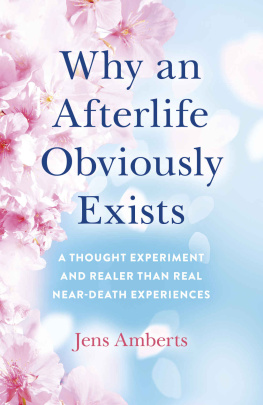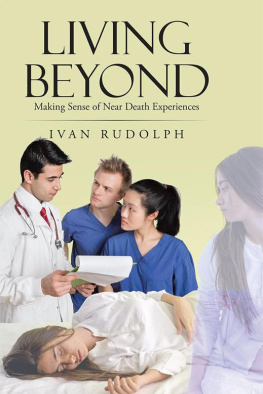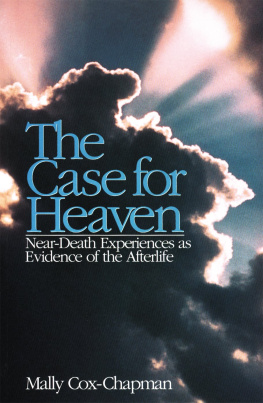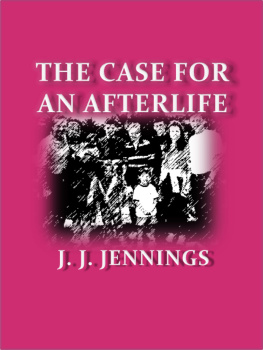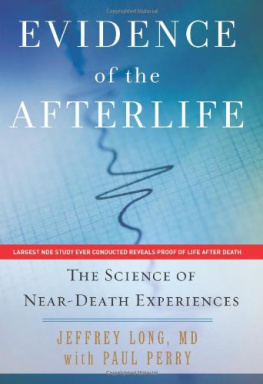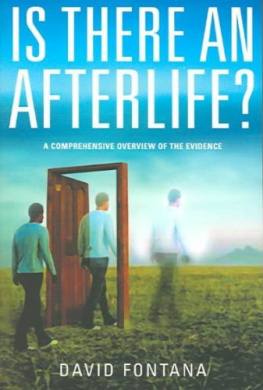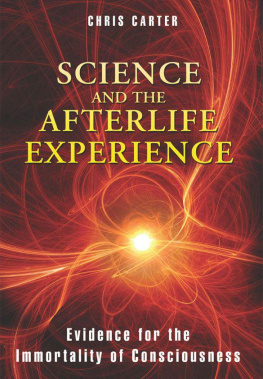Jeffrey Long - Evidence of the Afterlife: The Science of Near-Death Experiences
Here you can read online Jeffrey Long - Evidence of the Afterlife: The Science of Near-Death Experiences full text of the book (entire story) in english for free. Download pdf and epub, get meaning, cover and reviews about this ebook. year: 2010, publisher: HarperCollins, genre: Science. Description of the work, (preface) as well as reviews are available. Best literature library LitArk.com created for fans of good reading and offers a wide selection of genres:
Romance novel
Science fiction
Adventure
Detective
Science
History
Home and family
Prose
Art
Politics
Computer
Non-fiction
Religion
Business
Children
Humor
Choose a favorite category and find really read worthwhile books. Enjoy immersion in the world of imagination, feel the emotions of the characters or learn something new for yourself, make an fascinating discovery.
- Book:Evidence of the Afterlife: The Science of Near-Death Experiences
- Author:
- Publisher:HarperCollins
- Genre:
- Year:2010
- Rating:4 / 5
- Favourites:Add to favourites
- Your mark:
- 80
- 1
- 2
- 3
- 4
- 5
Evidence of the Afterlife: The Science of Near-Death Experiences: summary, description and annotation
We offer to read an annotation, description, summary or preface (depends on what the author of the book "Evidence of the Afterlife: The Science of Near-Death Experiences" wrote himself). If you haven't found the necessary information about the book — write in the comments, we will try to find it.
Jeffrey Long: author's other books
Who wrote Evidence of the Afterlife: The Science of Near-Death Experiences? Find out the surname, the name of the author of the book and a list of all author's works by series.
Evidence of the Afterlife: The Science of Near-Death Experiences — read online for free the complete book (whole text) full work
Below is the text of the book, divided by pages. System saving the place of the last page read, allows you to conveniently read the book "Evidence of the Afterlife: The Science of Near-Death Experiences" online for free, without having to search again every time where you left off. Put a bookmark, and you can go to the page where you finished reading at any time.
Font size:
Interval:
Bookmark:
DEDICATED TO THE THOUSANDS OF PEOPLE WHO HAVE SHARED THEIR
EXCEPTIONAL EXPERIENCES WITH US OVER THE YEARS, AND TO THOSE
WHO WILL SHARE IN THE FUTURE. YOU ARE AMONG THE GREATEST OF
TEACHERS.
DEDICATED TO NEAR-DEATH-EXPERIENCE RESEARCHERS,
PAST AND FUTURE.
DEDICATED TO JODY LONG, WHOSE EFFORTS MADE THIS BOOK POSSIBLE.
A bit beyond perceptions reach
I sometimes believe I see
that Life is two locked boxes, each
containing the others key.
Piet Hein
It was 1984 when I first stumbled upon the phrase near-death experience (NDE) in the pages of a medical journal. It was several years later that I heard a friends wife tell of her own NDE when she nearly died of an allergic reaction while under general anesthetic. More than ten years later, in 1998, I started the Near Death Experience Research Foundation and its corresponding website, NDERF.org.
One of my goals for the site was to collect as many NDEs as I could and to collect them through a questionnaire that would make it easy to separate and study their elements. With such a questionnaire, I could examine the individual elements in NDEs or an entire NDE itself. I expected to be successful in an endeavor, but as it has turned out, I have been wildly successful. Over the course of the first ten years, more than 1,300 people who had a near-death experience spent many hours of their precious time answering over one hundred questions in NDERFs detailed questionnaire. These people are of every race, creed, and color and are from virtually every corner of the world.
That so many people are willing to share their NDEs with others speaks volumes about the power of these experiences in a persons life. Respondents describe their experiences in a variety of ways, calling them unspeakable, ineffable, unforgettable, beautiful beyond words, and so on. More than 95 percent of the respondents feel their NDE was definitely real, while virtually all of the remaining respondents feel it was probably real. Not one respondent has said it was definitely not real. Some say it was not only the most real thing to ever happen to them but also the best event of their lives. As one respondent who nearly died in a suicide attempt wrote:
I was at peace with myself. Nothing hurt. I could only see my life and self through that Beings Love. There was no negative in myself or from that Being for anything I had done, including killing myself. It [my deed] was changed by the power of the Truth of Love, with which it was seen. That Loving Grace, total acceptance, complete love and truth created a joy in me. I saw that love was in me too, not just from the Being shining down on me; it was in me as part of myself. I was full of love and peace. I felt the joy in that truth. I have no right words for it.
I have seen this type of response from many people with near-death experiences. Imagine thatan experience that begins with the sheer terror of a life-threatening event and evolves into an event of wonder and mystery!
I am a man of science, and as a result I have examined the data from the NDERF study in a scientific way. At NDERF we explored all of the elements in the NDEs of more than one thousand people, examining consistency among the accounts. In reaching conclusions about these accounts, we followed a basic scientific principle: What is real is consistently seen among many different observations.
The results of the NDERF study clearly indicate remarkable consistency among NDE case studies. This study finds that what people discovered during their near-death experience about God, love, afterlife, reason for our earthly existence, earthly hardships, forgiveness, and many other concepts is strikingly consistent across cultures, races, and creeds. Also, these discoveries are generally not what would have been expected from preexisting societal beliefs, religious teachings, or any other source of earthly knowledge.
In a world that is plagued by afflictions of the soul, this is very good news. Many of the personal and social problems that face humanitydrug and alcohol abuse, depression, anxiety, gang violence, religious strife, racism, and so oncould be greatly affected by such a powerful common experience. Because NDEs happen to people all over the world, they are a spiritual thread that binds us together, a common experience that reminds us of our mutual spiritual nature. At its very least, the NDERF study contributes information that strengthens our understanding of that spiritual thread.
But the NDERF study is also exceptionally valuable in the way that it brings us closer to understanding what happens when we die. I long ago quit believing that death is the cessation of our existence. It took me a long time to reach this point. I was born into a scientific family. My father was the chair of the Department of Pharmacology at the University of Iowa and a onetime contender for the Nobel Prize. Through him and others in our family I developed great respect for science.
By scientifically studying the more than 1,300 cases shared with NDERF, I believe that the nine lines of evidence presented in this book all converge on one central point: There is life after death.
The convergence of several lines of evidencelike the nine presented in this bookbuilds a much stronger case than only a single line of evidence.
For example, suppose we had only two lines of NDE evidence. We may not be 100 percent convinced that these two lines of evidence prove an afterlife, but perhaps each line of evidence by itself is 90 percent convincing. Combined, these two lines of evidence by mathematical calculation are 99 percent convincing that the afterlife exists.1
Given how complex it is to mathematically analyze only two lines of evidence, imagine how mind-boggling it would be to mathematically analyze all nine lines of NDE evidence. Fortunately, that wont be necessary. The NDERF website includes a custom-designed form that automatically performs these mathematical calculations. This website wizardry allows you to calculate for yourself how strongly you believe the nine lines of evidence prove the existence of an afterlife. You can also see the results obtained from every other person who has completed this form. This form, and other material supplementing this book, is available on the NDERF website at our page that explores evidence of the afterlife (http://www.nderf.org/afterlife). The form addresses concepts presented throughout this book. Thus I would encourage you to finish reading this book before you complete the form.
WHAT HAPPENS DURING A NEAR-DEATH EXPERIENCE
Before continuing, I should provide a detailed explanation of what a near-death experience is.
Near-death experiences (NDEs) are events that take place as a person is dying or, indeed, is already clinically dead. People who have NDEs are called near-death experiencers (NDErs). From the time near-death experiences were first medically researched and described by Dr. Raymond Moody in his pioneering book, Life After Life, in 1975, medical doctors and other researchers have examined this phenomenon in depth.2
There is no widely accepted definition of near-death experience. The NDERF study took a straightforward approach by defining both the near-death and experience components of near-death experience. I considered individuals to be near death if they were so physically compromised that they would die if their condition did not improve. The NDErs studied were generally unconscious and often apparently clinically dead, with absence of heartbeat and breathing. The experience had to occur at the time they were near death. Also, the experience had to be lucid, to exclude descriptions of only fragmentary and disorganized memories.
Throughout this book we will present the results of the NDERF survey. Unless otherwise indicated, these will be the results from surveying 613 sequential NDErs who completed the most recent version of the NDERF survey.3 This version of the survey included the NDE Scale questions.4 The NDE Scale asks sixteen questions about the content of the experience and is the most validated research method to help distinguish experiences that are near-death experiences from those that are not. The 613 NDErs whose survey results we are presenting here all had NDE Scale scores of 7 or above, further validating these experiences as actual NDEs. The original version of the NDERF survey studied responses from 413 NDErs. The NDE Scale questions were not used in the original NDERF survey.
Font size:
Interval:
Bookmark:
Similar books «Evidence of the Afterlife: The Science of Near-Death Experiences»
Look at similar books to Evidence of the Afterlife: The Science of Near-Death Experiences. We have selected literature similar in name and meaning in the hope of providing readers with more options to find new, interesting, not yet read works.
Discussion, reviews of the book Evidence of the Afterlife: The Science of Near-Death Experiences and just readers' own opinions. Leave your comments, write what you think about the work, its meaning or the main characters. Specify what exactly you liked and what you didn't like, and why you think so.


